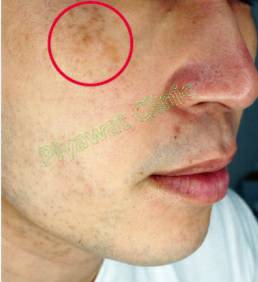English( Please scroll down)
後天性真皮メラノサイトーシス(ADM)について
後天性真皮メラノサイトーシス(ADM) は、太田母斑のような後天性両側母斑として、1984年にDr. Hori によって最初に報告されました。思春期から中年の東アジアの女性、特に日系および中国系の女性に最も多く見られます。
【症状】
ADMは、直径1~3mmの複数の点状および灰褐色の色素沈着が額や頬骨領域の両側に現れます。
ADMは、額、こめかみ、まぶた、頬部、鼻翼、および鼻根に発症する可能性があります。しかし、太田母斑とは異なり、これらの色素性病変は口や鼻の結膜や粘膜には見られません。ADMは主には顔に発症しますが、四肢などの他の身体には発症する報告もあります。
病理組織学的には通常の皮膚の構造を乱す事なく表皮基底層に不規則な形の双極性メラノサイトが見られます。
【原因】
ADMの原因はよく分かっていません。病変部の真皮基底層にメラノサイトの増殖が見られるため、研究者によっては紫外線、ホルモンまたはその他の要因によって活性化されたのではと仮説が立てられていました。ADMのほとんどの症例は散発性であり遺伝的要因はあまり関係がないようです。
【治療方法】
ADMは、肝斑治療と同じ方法で治療できますが肝斑よりも治療が困難です。1つの治療法だけでなく、数種類の治療の組み合わせがお勧めです。
※Qスイッチレーザーは、ADM治療の1番の治療法です。より新しいレーザーを使用することで効果は高くなります。ピヤワットクリニックでは、US FDAによって承認された最新のQスイッチレーザーモデルを使用しています。
※グリコール酸などのケミカルピーリングは、ADM 治療に役立つことが報告されています。
※日頃のスキンケア: 日焼け止めと美白用スキンケアは ADM治療に有効です。ピヤワットクリニックでは、主に天然由来の成分が配合されているホワイトニング製品を取り揃えています。
Acquired dermal melanocytosis (ADM) was first reported by Hori in 1984 as acquired bilateral nevus of Ota-like macules. It is most frequently seen among adolescent to middle-aged East Asian women, particularly those of Japanese and Chinese descent.
Symptom
✔️ADM manifests as multiple punctate and greyish-brown pigmented areas 1–3 mm in diameter occurring on both sides of the forehead and zygomatic region.
✔️ADM can involve the forehead, temples, eyelids, malar areas, nasal alae, and nasal root.
✔️Unlike the nevus of Ota, these pigmented lesions are not observed in the conjunctiva or mucous membranes of the mouth or nose.
✔️Although ADM affects mainly the face, there are also reports of other body areas involvement such as extremities.
Histopathology
Histopathological examination generally reveals irregularly-shaped, bipolar melanocytes in the upper and middle dermis without disturbance of the normal skin architecture.
Cause
The pathogenesis of ADM is not well understood. There is a research found immature melanocyte in the dermis of lesion of ADM. So the researcher hypothesized that these immature melanocyte is activated by UV-radiation, hormone (estrogen and/or progesterone), and some other factors.
Although a positive family history has been reported in one study, most cases of ADM are sporadic and genetic factors have not been suggested.
Treatment
ADM can be treated in the same way as melasma treatment. ADM is more difficult to treat than melasma. Combination of the treatment is highly recommended.
✔️Q switch laser is the major priority for ADM treatment. New laser model should get more effectiveness than older machine. At Piyawat Clinic, we use the newest Q switch Laser model approved by USFDA.
✔️ Chemical peeling such as Glycoric acid is reported to be helpful for ADM treatment.
✔️ Daily products: Sunscreen and whitening agent are helpful for ADM treatment. At Piyawat Clinic, we use mainly on natural whitening agents.
